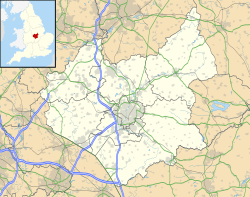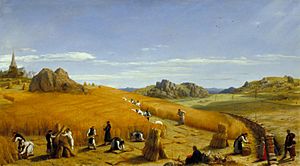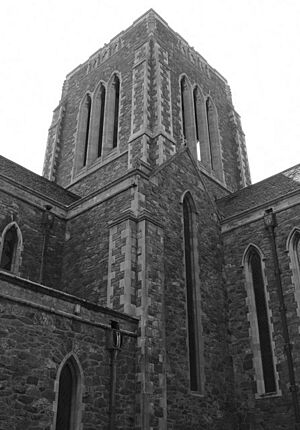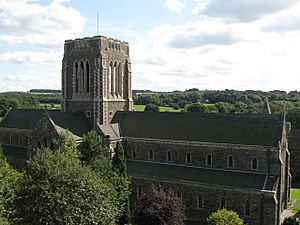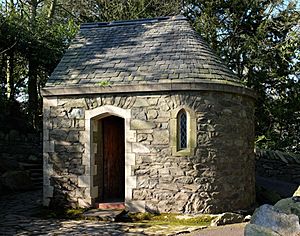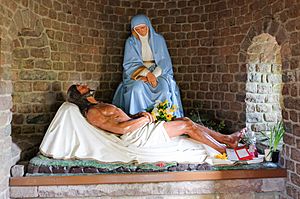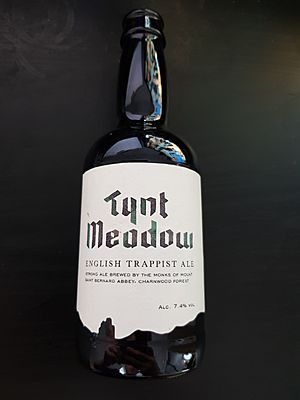Mount St Bernard Abbey facts for kids
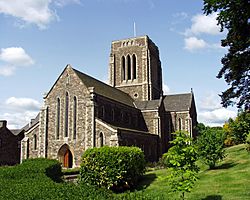
Mount St Bernard Abbey
|
|
| Monastery information | |
|---|---|
| Order | Trappists |
| Established | 1835 |
| Abbot | Dom Joseph Delargy, OCSO |
| Site | |
| Location | Near Coalville, Leicestershire, England |
| Coordinates | 52°44′29″N 1°19′23″W / 52.741352°N 1.323072°W |
| Public access | yes |
Mount St Bernard Abbey is a Roman Catholic monastery in Leicestershire, England. It belongs to the Trappist Order. Founded in 1835, it was the first permanent monastery built in England since the Reformation. It is also the only Trappist monastery in England. The monks here make the only Trappist beer in Britain.
Contents
History of the Abbey
How the Monastery Started
The story of Mount St Bernard Abbey began with other groups of Cistercian monks. Some Trappist monks came to London in 1794 after their monasteries in France were closed. They planned to move to Canada. A kind Catholic man named Thomas Weld gave them land in Lulworth, Dorset, to build a monastery.
The monks stayed at Lulworth until 1817. They then went back to France to restart an old monastery called Melleray Abbey. But after another revolution in 1830, they faced problems again. They left France and started Mount Melleray Abbey in Ireland in 1833. In 1835, a small group of monks from Mount Melleray came to England to start Mount St Bernard.
The Cistercian order began in the 1100s. The Trappists are a special part of the Cistercian order, started in the mid-1600s. Mount St Bernard is the only Trappist abbey in England.
Building the Abbey
Mount St Bernard Abbey was founded in 1835. A local landowner and Catholic convert, Ambrose Lisle March Phillipps, bought 227 acres (0.92 km2) of land. He wanted to bring monastic life back to England. His family home, Garendon Hall, was built where an old Cistercian abbey once stood.
The land the monks received in September 1835 was mostly wild. It had an old area called Tynt Meadow. The first monks lived in a small, run-down cottage called Tynt Meadow House. These first monks included Augustine, Luke, Xavier, Cyprian, Placid, Simeon, and Father Odilo Woolfrey.
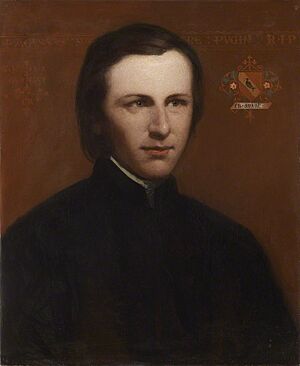
Work on a temporary monastery began in 1837. It was designed by William Railton, who also designed Nelson's Column in London. The buildings were in a style that looked like old Tudor houses. The church was blessed on October 11, 1837. However, these buildings were soon replaced by a bigger, more impressive monastery.
In 1844, a new, permanent monastery opened. It was built with money from John Talbot, 16th Earl of Shrewsbury, and other helpers. The famous architect Augustus Pugin designed it for free. Pugin wanted the buildings to be simple and strong, with thick walls and narrow windows. He said the monastery should show "solemnity and simplicity."
The church was blessed on August 20, 1844, which is Saint Bernard's feast day. But it was not finished for over ninety years. Only the main part of Pugin's church was built because there wasn't enough money. A small bell tower was added to the unfinished church.
The monastery is protected on its north side by a large rock called Kite Hill. There was a disagreement about whether this rock belonged to the monastery or the nearby town. The local police decided in favor of the monks. A Calvary (a sculpture of Jesus on the cross) was put on top of the rock. Visitors can climb to it using stone steps made by the monks.
Roman Coins and Famous Visitors
On June 2, 1840, monks and workers found an old pot with about 2000 Roman coins while farming. The coins were from the 200s AD. This made people think that Romans might have lived on the land. Other Roman items like a small arrow and pottery pieces were also found. These finds suggested there might have been a Roman military post there. Today, some of these coins are kept at the Newarke Houses Museum in Leicester.
The new monastery quickly became a popular place to visit. Famous people like William Wordsworth and Florence Nightingale came to see it. Many important English church leaders also visited, such as Nicholas Wiseman and John Henry Newman. Writers and important people from other countries also came.
William Wordsworth visited in 1841. He wrote about the monastery's beautiful location among wild rocks. He saw monks working hard in their simple clothes.
Pre-Raphaelite artist Edward Burne-Jones visited the monastery as a young boy in 1851. This visit deeply affected him. Years later, he wrote about how he longed for the peace of the monastery. He often spoke of wanting to leave everything and join the monks.
Charles Dickens is said to have spent time at the abbey. He also sent two of his employees, Edmund Yates and Thomas Speight, to write articles about the monastery for his magazines.
Many architects found inspiration in Pugin's design for Mount St Bernard. Joseph Hansom visited twice. Another architect, George Frederick Bodley, was so inspired that he kept a description of the abbey by his bed.
Helping Those in Need
Throughout its history, the monastery has been a place of help for the poor and hungry. A priest named Luigi Gentili noted that there was extreme poverty in Leicestershire, even worse than in his home country of Italy. Many Irish immigrants came seeking help during the Great Famine of the 1840s. The monks fed thousands of people each year. In 1845, they gave lodging to 2,788 people and food to 18,887. In 1847, they helped 36,000 people.
In 1848, Pope Pius IX made the monastery an abbey. Its first abbot, Dom Bernard Palmer, was blessed in 1849. The monastery officially became part of the Trappist Order that same year.
In 1862, John Rogers Herbert painted Laborare est Orare (To work is to pray). It showed the monks harvesting with boys from a nearby school. The painting shows the church with a tower and spire, which was Pugin's original plan, even though the abbey didn't have one at that time.
In 1878, many miners and their families faced hardship. The monastery gave out large amounts of soup to the unemployed every day. They did this again during the General Strike of 1926.
Growth and Changes
The abbey faced money problems and a lack of new monks in the 1800s. But things improved in the 1900s. The church building was extended between 1935 and 1939. The new design, led by Abbot Malachy Brasil, placed the altar in the center. This was a very modern idea for the time.
During the First World War, six monks from Mount St Bernard were called to serve in the military in 1917. This was a big loss for the monastery, as it only had twenty monks then.
Leslie Hore-Belisha, a former government official, stayed at the abbey in 1942. He said it was important to have time for quiet thought. He often visited the abbey, sometimes for many weeks.
The Nigerian priest Cyprian Michael Iwene Tansi was a monk at the abbey from 1950 until he passed away in 1964. He was buried at the abbey, but his remains were later moved to Nigeria. He was made a "Blessed" by Pope John Paul II in 1998. A sculpture in the abbey church remembers Father Cyprian.
In 1952, the remains of twenty-six Cistercian monks from an old monastery in Lulworth were reburied at Mount St Bernard.
The famous actor Alec Guinness visited Mount St Bernard many times after becoming Catholic in 1956. In his book, he described attending a morning Mass. He was amazed by the sight of monks saying Mass at different altars as the sun rose. He felt a strong sense of God's presence and the peaceful, hardworking atmosphere of the abbey.
In the late 1950s, there was a public outcry about the planned route of the M1 motorway passing near the abbey. The monks, who had taken a vow of silence, signed a petition against it. This led to the road being moved to its current path.
In 1978, artist Stanley Roseman visited the abbey. He painted portraits of two monks, "Father Benedict" and "Father Ian." The painting of Father Ian is now in a museum in France.
The abbey buildings were recognized as important historical sites in 1989. Experts have suggested they should be given even higher protection due to their architectural and historical value.
In 1998, it was reported that footballer Justin Fashanu sought comfort at the abbey in his final days.
In 2009, the skeletons of over 600 medieval Cistercian monks were reburied at Mount St Bernard. These remains were found during construction work in London. The abbot, Dom Joseph Delargy, explained that the abbey is not just the buildings, but the people. He said that with the monks' remains now at Mount St Bernard, the spirit of the old abbey was also there.
In 2012, when the remains of Richard III of England were found, Mount St Bernard Abbey was suggested as a temporary resting place. This was because Richard III was a Catholic king before the Reformation. However, his remains were eventually reburied at Leicester Cathedral.
In January 2021, two human bones were found during construction work at the abbey. The police confirmed they were not related to any crime. The monks decided to rebury the bones where they were found with a simple ceremony.
Abbots and Leaders
The monastery has been led by many abbots and superiors over the years.
The first leader of Mount St Bernard was Dom Odilo Woolfrey. He also served as a priest for nearby Catholic churches. Later, he and his brother became missionaries in Australia.
In 1839, Dom Benedict Johnson became the new superior. He had joined the Lulworth monastery in 1813. He passed away at Mount St Bernard in 1850.
Dom John Bernard Palmer became superior in 1841. He was elected the first abbot in 1849. He was known for his kindness and helping the poor. He was the only abbot in England with a special hat (mitre) at that time. Abbot Palmer was buried in the abbey grounds.
After Abbot Palmer, Dom Bernard Burder became the second abbot in 1853. He had a changing life, first becoming an Anglican priest, then converting to Catholicism. He thought the Trappist life was too strict for Englishmen. He resigned in 1858 after an investigation.
In 1859, Dom Bartholemew Anderson became superior and then abbot in 1863. He led the community for thirty years, the longest time of any leader. He added buildings like the Clock Tower. He was also interested in connecting with non-Catholics. Prime Minister William Gladstone visited him in 1873.
Dom Wilfred Hipwood became abbot in 1890. He was a gentle and smart man. He was often ill, and the number of monks decreased during his time.
In 1910, Dom Louis Carew became the provisional superior. He was known for his strict discipline. The number of monks remained low during his time.
Dom Celsus O'Connell became superior in 1927. The community started to grow again. He was elected abbot in 1929 but later moved back to Ireland.
The monastery continued to grow under Dom Malachy Brasil, who became abbot in 1933. During his time, the abbey church was completed. He also improved the grounds and guesthouse. The number of monks reached its highest point. He retired in 1959.
Dom Ambrose Southey became abbot in 1959. He was the first Englishman to lead the abbey in over fifty years. He later became the highest leader of the entire Trappist order worldwide. He returned to Mount St Bernard and passed away there in 2013.
Dom Cyril Bunce became abbot in 1974, followed by Dom John Moakler in 1980, and Dom Joseph Delargy in 2001.
Dom Joseph Delargy retired in 2013. After that, Dom Erik Varden from Norway became the superior and then abbot in 2015. He was the first abbot not born in Britain or Ireland. He started the abbey's brewery. In 2019, he was appointed a bishop in Norway.
In January 2020, the monks re-elected Dom Joseph Delargy as their abbot. He resigned in 2022, and Dom Peter Claver Craddy became superior. Dom Joseph Delargy was elected abbot again in 2023.
Notable Monks
Some monks at Mount St Bernard Abbey became well-known beyond the monastery.
- Anselm Baker (1834 - 1885) was an artist who drew coats of arms. He joined the abbey in 1857. He also painted murals in chapels.
- Henry Augustine Collins (1827 - 1919) was a hymn writer. He joined the abbey in 1861 and wrote famous hymns like 'Jesus, my Lord, my God, my all'.
- Hilary Costello (1926 - 2018) was a writer. He joined the abbey in 1947. He wrote many books and articles about Cistercian history. He was also the abbey's bookbinder for some years.
- Vincent Eley was a sculptor, woodcarver, and potter. He wrote a book about pottery at the abbey. He created the statues on the Calvary.
- Robert Henry Smith (1807 - 1866) was a writer. He joined the abbey in 1848. He wrote books about the Cistercian Order and translated others.
- Erik Varden (born 1974) is a writer and musician. He became the abbot in 2015 and later a bishop in Norway. He helped start the abbey's brewery.
Some monks at Mount St Bernard have lived very long lives. Father Peter Logue lived to be 96, and Brother Gabriel Manogue lived to be 99.
Life at the Abbey Today
The monks wake up at 3:15 am every day and go to bed at 8:00 pm. They used to sleep in large dormitories, but now each monk has his own room for more quiet and prayer.
Monastic life at Mount St Bernard Abbey focuses on three things: prayer, work, and reading with study. They pray together daily in services called Opus Dei. They also read the Bible thoughtfully, which is called Lectio Divina. Silence and quiet time are very important to their order.
Their work includes making pottery, binding books, keeping bees, and tending the vegetable garden and orchard. They also have a gift shop where they sell items made at the abbey. The abbey has a guesthouse for visitors, including friends and family of the monks, and people interested in monastic life.
Until 2014, the monks ran a 200-acre (0.81 km2) dairy farm. But milk prices dropped, so they started a brewery instead. This is a tradition for many monasteries in Europe. Records show that monks at Mount St Bernard brewed beer as early as 1847.
Trappist monks eat a vegetarian diet. A doctor in 1955 suggested that the monks at Mount St Bernard had "excellent health" and lived long lives because of this diet.
When a monk passes away at Mount St Bernard, he is buried without a coffin. The community uses a special communal coffin for funerals, which is then returned to the attic. The monk's body is lowered into the ground, and his brothers gently cover him with earth.
Life at the Abbey was shown in a 2012 TV program. In 2019, a documentary called Outside the City was made about the abbey. It showed the monks' daily life. This documentary was later shown on BBC Four in March 2021 as Brotherhood: the Inner Life of Monks. The abbey was also featured on BBC Songs of Praise in March 2022.
Mount St Bernard Abbey has a friendly connection with the Anglican Cistercians, a group of men within the Church of England who follow a similar monastic way of life.
In 2005, the monastery had 35 monks and received about 50 applications to join each year. Around 5000 guests stayed at the monastery annually. Guests can stay for up to five days for free, though donations are welcome. By 2021, there were 25 monks, with more than half over 80 years old.
In 2017, the community joined the International Trappist Association. This helps them develop their craft economy after closing the dairy farm.
The abbey also has a presence on Facebook, with over 10,000 followers.
Abbey Church and Grounds
The Abbey Church is dedicated to God, the Blessed Virgin Mary, and St Bernard.
The church's simple Gothic style is traditional for Cistercian buildings. Pugin used ideas from old Cistercian abbeys to create its plain beauty. He personally oversaw the building of the western part, finished in 1844.
The monks quarried the granite for the monastery from their own land. Other stones came from nearby quarries. In 1839, the founder, Ambrose Phillipps de Lisle, wrote about how a railway contractor gave them iron rails to move stone. Also, the owner of a lime works gave them all the lime they needed for free.
In 1934, work began to extend the abbey church. Eighty monks worked for four years to make the building much longer. The architect, F. J. Bradford, designed the extension to match Pugin's original style.
Inside the Church
The church's current decorations and furniture are from the 1900s. The community chose a more modern style.
The altar is made of the same stone as the church. It was designed by David John, who also created art for other important churches.
The hanging container for the Body of Christ (called a pyx) is made of stainless steel and copper. It was designed by Father Alban Buggins.
The wooden crucifix and stone plaques were made by Father Francis O'Malley.
Above the central altar, there are three shields. They represent the Pope at the time the church was finished, the Cistercian order, and Mount St Bernard Abbey.
The Choir stalls, where the monks sit, were designed by Eric Gill in 1938.
The tomb of the founder, Ambrose Phillipps de Lisle, is in the south aisle of the original church. His wife, Laura Clifford, was also buried there later.
A statue of Mary and the Child Jesus, made by Costa in 1958, is above the east porch. It is a copy of a design from an old abbey.
The Organ
The current pipe organ was installed in 2014. It was brought from a church in Munich, Germany.
An earlier organ was installed in 1937. It was later given to a college chapel. An electronic organ replaced it in 1962.
After fifty years, the electronic organ needed to be replaced. In 2013, a friend of the abbey, Stefan Heiß, found a beautiful pipe organ from a church that was being torn down in Munich. With donations, the organ was restored and rebuilt at the abbey. It was placed on a platform above the central area of the church.
Church Size and Features
- Total length: 222 feet (67.7 meters)
- Total width: 43 feet (13.1 meters)
- Width at transepts: 94 feet (28.7 meters)
- Greatest interior height: 52 feet (15.8 meters)
- Height of tower: 100 feet (30.5 meters)
- Walls are 3 feet (0.9 meters) thick.
Outside the Church
The carved heads on the outside of the church were made by Father Vincent Eley and Robert Kiddey. They show four angels and eight famous Cistercian figures.
The stone water spouts (called armorial water heads) have the coats of arms of twenty Cistercian monasteries that were closed by Henry VIII. These include Garendon Abbey and Fountains Abbey.
The tower was designed by Albert Herbert. It is 100 feet (30.5 meters) tall and holds two bells. The bells, named 'Maria' and 'Bernard', were made in 1936. The original small bell from 1852 was given to another church in 2005.
Cemetery and Monuments
In the monastery's cemetery, there are two plaques for Everard Aloysius Lisle Phillipps, the son of the abbey's founder. He was a brave soldier who was recognized for his actions in India in 1857.
Other notable people buried here include Vice-Admiral Robert Hall, a veteran of the Crimean War, and James Tisdall Woodroffe, a former lawyer from India.
Musician Caspar Pound and his father Pelham Pendennis Pound are also buried here. Their monument has the words "Rising High."
There are also monuments to local Catholic families, like the De Lisles.
Calvary Monument
A wooden calvary (a cross with Jesus) was first put on the granite rock north of the abbey church on August 20, 1847. Many people gathered for the event. The original cross was very large and could be seen from far away.
The current sculptures on the calvary rock were made by Father Vincent Eley in 1965. They show Jesus on a concrete cross, with images of Mary and St John beside him.
This Calvary was only the second one built in England since the Reformation. The first was on the founder's other estate nearby.
Chapel of Dolours
The small Chapel of Dolours, also called the Chapel of the Holy Sepulchre, is on a hill north of the monastery. It was built in 1842 by Pugin and used to be in a different location. It was inspired by similar shrines in Germany.
The chapel contains two beautiful wooden figures made by Austrian sculptor Johann Petz. They show the Blessed Virgin Mary weeping over her son, Jesus, after he was taken down from the Cross.
By the mid-1900s, the chapel was damaged. In 1955, it was taken apart and rebuilt at its current spot by the monks.
E. W. Pugin's Work
In Cademan Wood, there are still foundations of a tower built between 1863 and 1864. This tower was a memorial to the founder's son, Everard Aloysius Lisle Phillipps. It was designed by Edward Welby Pugin, the son of Augustus Pugin. The tower looked like a medieval fortress. It has since been taken down.
E. W. Pugin also rebuilt the Chapter House in 1860. This octagonal building has a special wooden figure of the Virgin Mary from the 1400s. It was found under the floorboards of a farmhouse.
He also made changes to the abbey's guesthouse. A stone cottage on the monastery estate, called The Lodge, is also thought to be designed by E. W. Pugin.
Trappist Beer: Tynt Meadow
In June 2018, the monks at Mount St Bernard Abbey became the first in the UK to brew Trappist beer. It is called "Tynt Meadow" (7.4% alcohol), named after the area where the abbey was founded. Visitors can buy it at the abbey and in stores.
In July 2019, it was reported that the abbey had made about 30,000 bottles of Tynt Meadow. The beer became very popular, especially in Belgium and the Netherlands. However, the brewery's main purpose is to support the monastery, not to become a huge business. So, the monks do not plan to produce more than they can manage.
Former School for Boys
In 1856, a school for Catholic boys who had gotten into trouble was started at Mount St Bernard. It was called St Mary's Agricultural Colony, or "The Colony." It was housed in the original monastery building, which is now gone.
The school faced some challenges, including incidents in 1864 and 1875. It closed in 1881 but reopened briefly in 1884–85 to house boys from a reformatory ship that had burned. Over its lifetime, 1,642 boys were admitted to the school.
All traces of the school building are gone. However, the Colony Reservoir, a small lake, remains nearby. It was used to supply water to the school. A large wooden cross marks the school's graveyard, where forty-two people, including boys and staff, are buried.
Sister Monasteries
In 1963, Mount St Bernard Abbey helped start a new monastery in Africa. This was Our Lady of Bamenda in Cameroon. It is now an independent and thriving abbey with mostly African monks.
Bamenda Abbey has also started its own new monastery, Our Lady of the Angels, in Nsugbe, Nigeria.
Monos Foundation
The Monos Foundation is a Christian organization located near the abbey. It aims to encourage a monastic spirit through community and education.
The building where the foundation is located was once a large Victorian house called "Charnwood Tower." It was home to Mrs. Emma Frances Haydock, who was a generous supporter of the local Catholic community. The house has also been a pub and a care home.
The Monos Foundation has renamed the building "The Mercian Centre." It also has the St Joseph Tearoom, which is open to the public six days a week.


